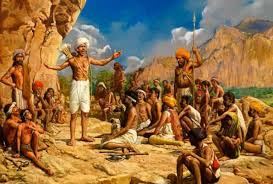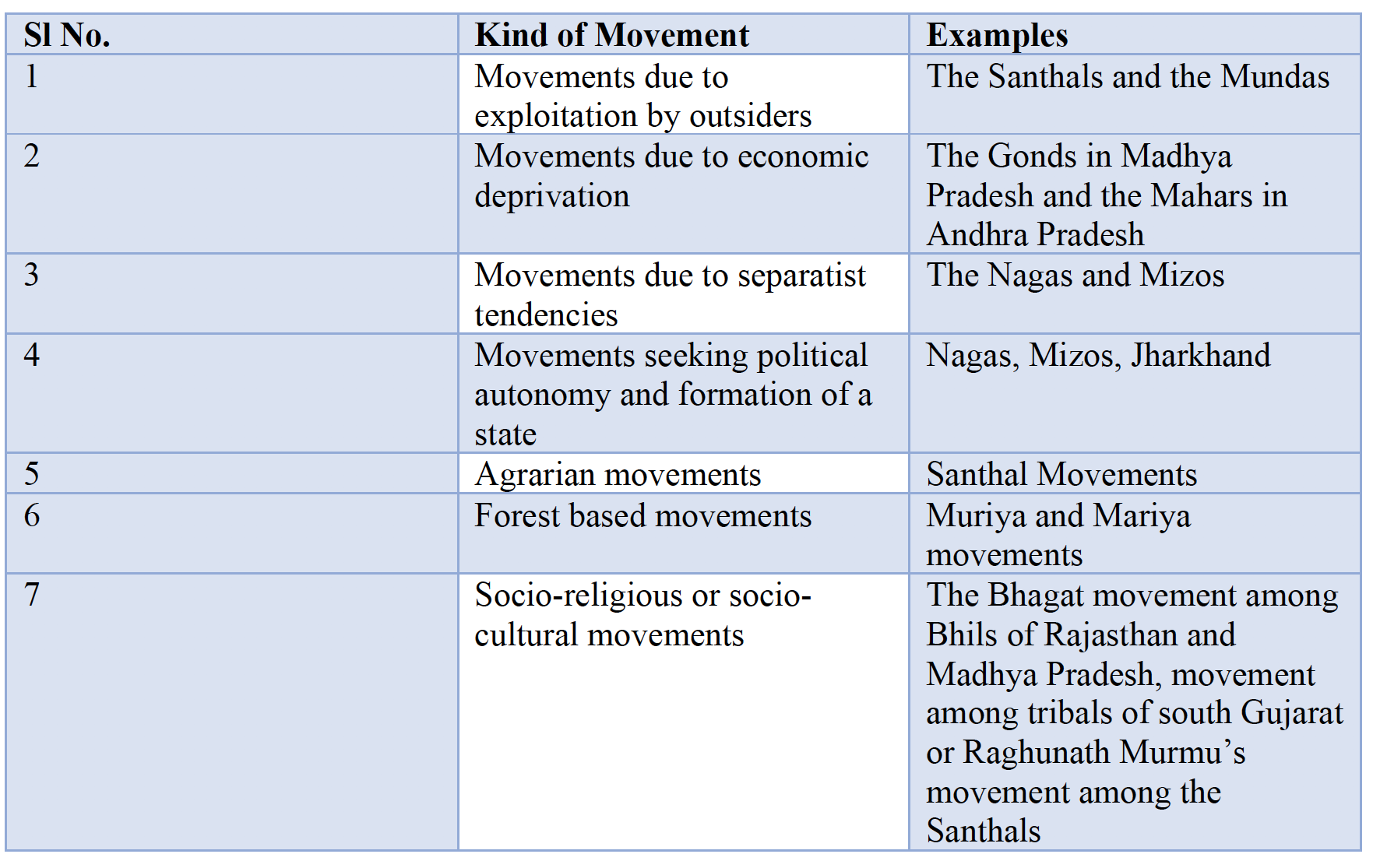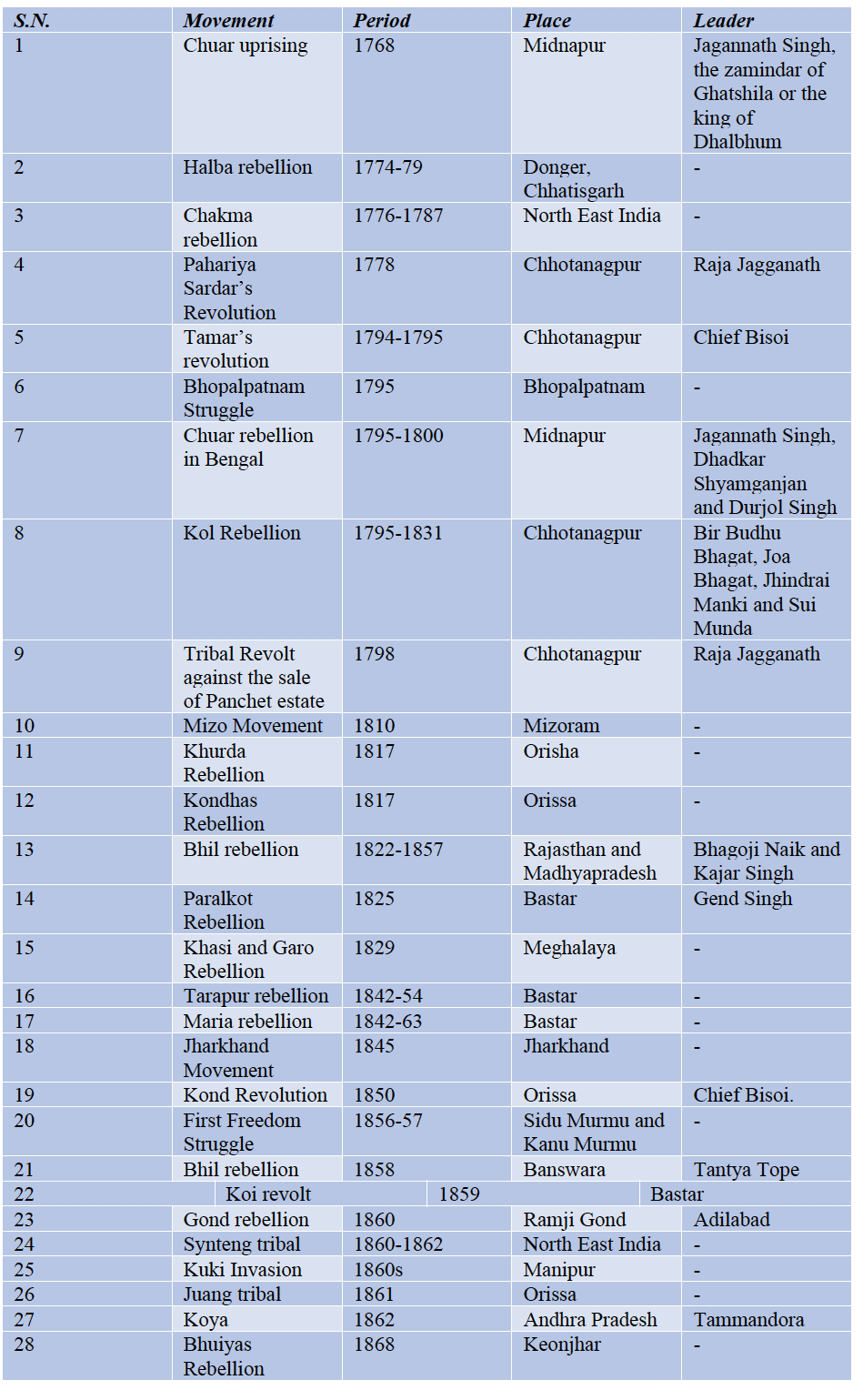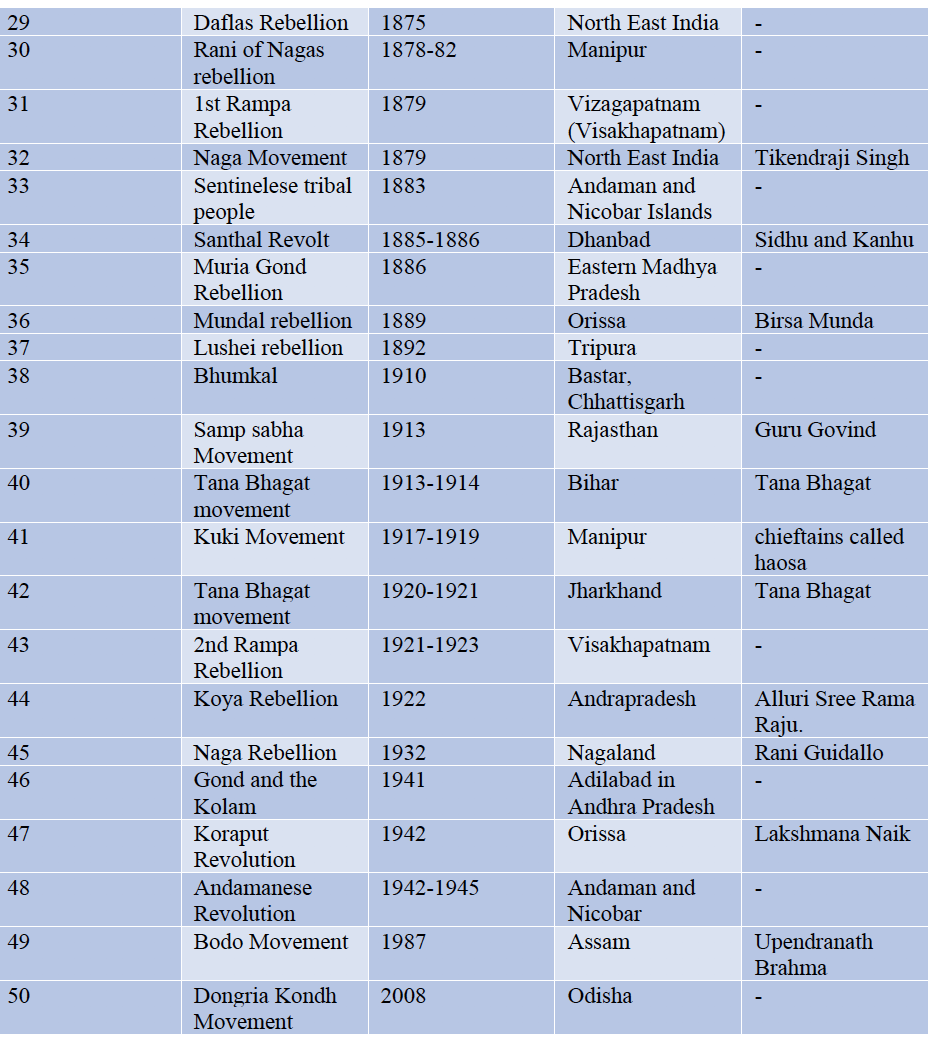LIST OF TRIBAL MOVEMENTS IN INDIA FROM 1768 ONWARDS

INTRODUCTION
India is known for its tribal or adivasi inhabitants. The term ‘adivasi’ connotes that they were the first or original inhabitants of the land, having original habitat, native to the soil. Tribes may be defined as a social group of a simple kind, the members of which speak a common dialect and act together for such common purpose as welfare. Tribes live in a definite habitat and area, remain unified by a social organisation that is based primarily on blood relationship, cultural homogeneity, a common scheme of deities and common ancestors and a common dialect with a common folk lore. Their habitat and culture not only provides them a sense of freedom, self identity and respect, it also empowers them to stand united against any kind of exploitation, oppression and harassment by outsiders like zamindars, kings, British and others.
BACKGROUND
- Before independence, tribal revolts stood primarily against alien rulers.
- Most of the tribal movements had their origins in religious upheavals. Vaishnavist movements were one of the important religious movements found among the Meithei tribe in Manipur, Bhumij in West Bengal, Nokte Naga in Assam, Bathudi in Orissa and tribals in Jharkhand, Orissa and south India. These were also found among Gonds in central India, Kondh in Orissa and Bhils in Rajasthan.
- In the early years of colonisation, no other community and even rulers of so many dynasties in India could put forward such heroic resistance to British rule and faced tragic consequences as did by the numerous Advise or tribal communities of present Jharkhand, Chhattisgarh, Orissa and Bengal.
- There were also movements against oppressing landlords, moneylenders and harassment by police and forest officials in Bihar, Bengal, Orissa and Chhattisgarh. For example, Bhagat movements were found among Oraon of Chotanagpur, Bhils of Rajasthan, etc.
- These were also revivalist movement for avoiding animal food, liquor and blood sacrifices.
- Apart from that, Mundas reformative movement was also reported under a powerful charismatic leader Dharti Aba who preached Hindu ideals of ritual purity, morality and asceticism and criticised the worship of priests.
- Extinction of two important resources of the tribals namely land and forest were at the helm of many tribal movements.
- Erosion on land rights of tribes began with the coming of the British rule and administration.
- It was brought about by a combination of forces that were at work during the British period. Of these the most important were the introduction of the private property in land and the penetration of the market forces. The two taken together opened up the way for large-scale alienation of land from tribes to non-tribes especially after the tribal areas came to be linked by roads and railways. The mechanisms through which this was achieved were fraud, deceit, coercion and the most widely debt bondage.
- The major source of land alienation in the post-independence period is not so much the encroachment of the non-tribals into the tribal land as the process of development that the Indian State has followed during the period. The large scale industrialisation and exploitation of mineral resources and the construction of irrigation dams and the power projects that the tribal areas have witnessed during the period have been the single most factors that have uprooted more people out of their lands than the transfer of land from tribals to non-tribals on the individual basis.
- At the extreme end, there are instances of tribal movements for the agenda of liberation. We can include the instances of Naga revolution, Mizo movement, and the Gond Raj movement, under this category.
- Thus, on the whole, tribes of India have launched different kinds of movements and these were mainly related to their issues of livelihood, socio cultural security, oppression and discrimination, neglect and backwardness, poverty, hunger, unemployment and exploitation.

MAJOR REASONS OF TRIBAL MOVEMENTS
Various reasons have stimulated the tribals for uprising. Historically speaking, however, there is a qualitative shift in tribal movement in independent India as compared to the period before 1947.
Before Independence
It is possible to classify tribal movement in India before 1947 into three types.
- The first type is called the ‘reactionary’ movement. It attempted to oppose political or social reform by the tribes mostly in the context of mixture with non-tribes. Such movement was mostly seen among the tribals living a simple and isolated life in forest. Whenever they saw alien groups creating obstacles in their life, they became offensive and tried to bring back the ‘good old days’.
- The second type is ‘conservative’ which opposed any kind of changes in tribal life and culture and sought to maintain status quo.
- And the third type is ‘revolutionary’ that aimed to replace certain traits of their traditional culture or social order with a progressive one. This movement is also termed as ‘revivalistic’ as the leaders of such movement also sought to ‘purify’ certain elements of culture by eliminating evil customs, beliefs and institutions.
Apart from these, there are several other attempts to classify tribal movements. For example there is a four fold classification which is based on i) political autonomy (e.g. Jharkhand movement), ii) agrarian (e.g. Santhal Movement) and forest based issues (Koi movement), iii) sanskritization (e.g. Bhagat movement), and iv) cultural movements for script and language (Bhil movement). Again, another leading expert has classified tribal movements into five types: a) Ethnic rebellion, b) Reform movements, c) Political autonomy movements within the Indian Union, d) Secessionist movements, and e) Agrarian unrest. For Dubey (1982), these movements are of four categories namely, a) Religious and social reform movements, b) Movements for separate statehood, c) Insurgent movements and d) Cultural rights movements. Shah (1990) too has categorised them in three groups which are Ethnic, Agrarian, and Political.
After Independence
- After independence, the Government of India and various state governments have made great and incessant efforts in the direction of tribal welfare and development.
- Various efforts have been made by these governments to improve the socio-economic status of the tribals and to guarantee constitutional safeguards given to tribal people.
- But, at the same time, the establishment of heavy industries, construction of dams and launching of development plans in tribal zones has necessitated displacement of local population.
- Destruction of forests as a consequence of felling of trees for industrial purposes has threatened the small communities of hunters and food gathers.
- In spite of some rehabilitation and resettlement programmes, unfortunately a large section of the tribals became the victims of developmental projects and they could not also adequately adopt themselves with new challenges.
- Against rising economic and social disparities, the tribals started raising their collective voice in independent India.
- The tribals especially in central India had reacted sharply against their exploiters.
- These movements were directed towards freeing their land from all those who exploited them economically and culturally.
- At the same time, each of these movements put emphasis on revitalisation of their culture, their traditional culture which was swayed under the impact of the outsiders.
- So, the basic issues behind the tribal movements in India after independence are: land alienation, unemployment, deprivation, cultural sub-mergence and unbalanced development.
It is possible to categories various tribal movements by their reasons in the following way:

Chronological list of some tribal movements in the following table since 1768:










